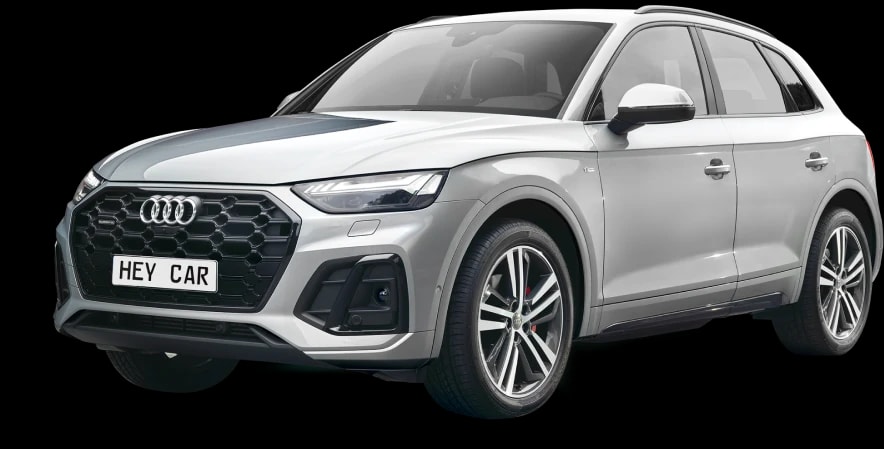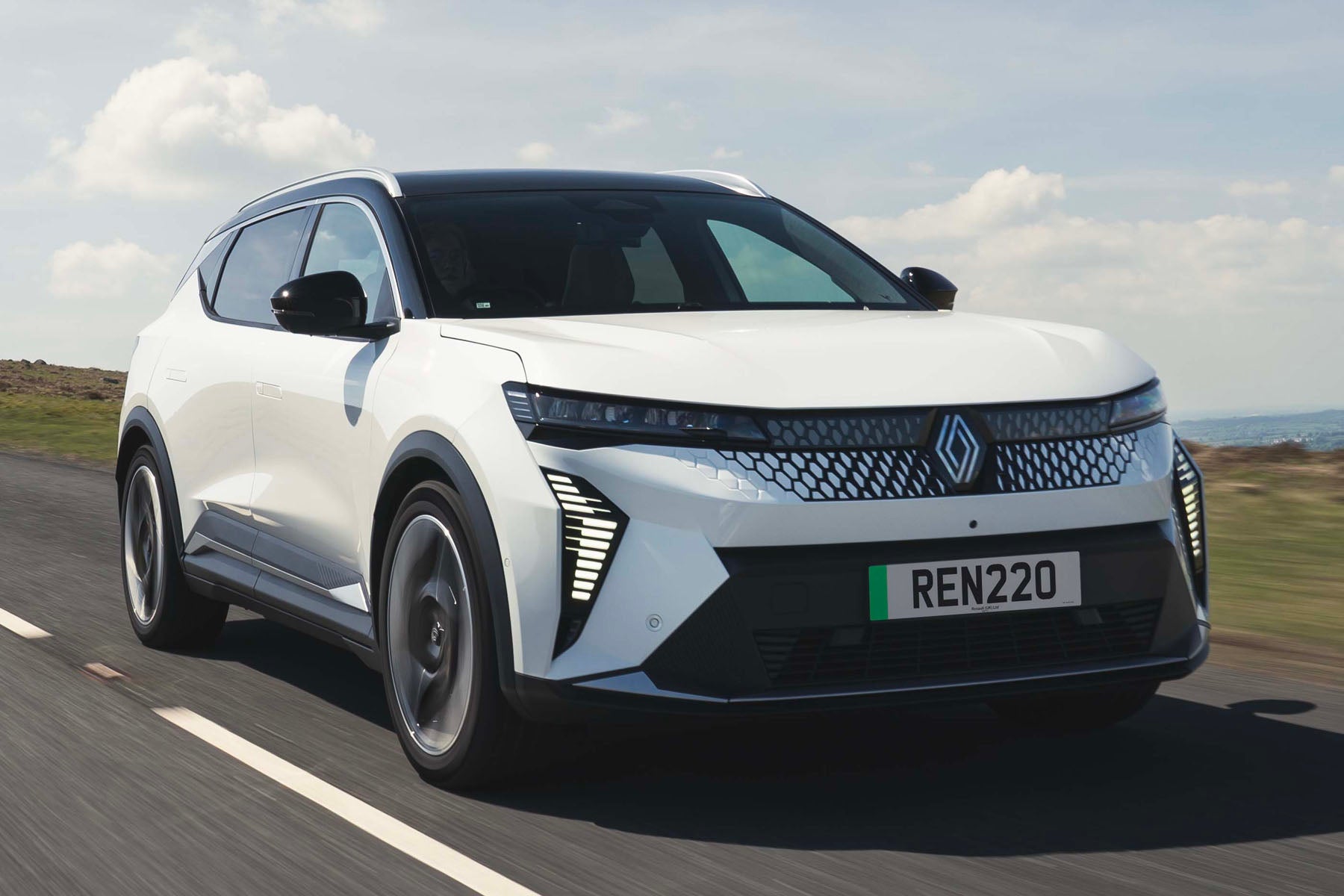Renault Scenic E-Tech Review 2025: Price, specs & boot space
Written by John Howell
- 2024
- SUV
- EV
Quick overview
Pros
- Great official range
- Practical and thoughtfully designed interior
- Relatively enjoyable to drive
Cons
- Poor rear visibility
- Not as quick as some rivals
- Ride can be fidgety
Overall verdict on the Renault Scenic E-Tech
"Renault has a legacy as one of the pioneers. Take the Renault Scenic, for example. That was one of the pioneering small MPVs, and followed the Renault Espace that pioneered the once-oh-so-popular MPV segment. Then there’s the Renault Zoe. True, that wasn’t the first mainstream electric car (the Leaf was, from sister-brand Nissan), but the Zoe was early to market offering electric power at a relatively affordable price."
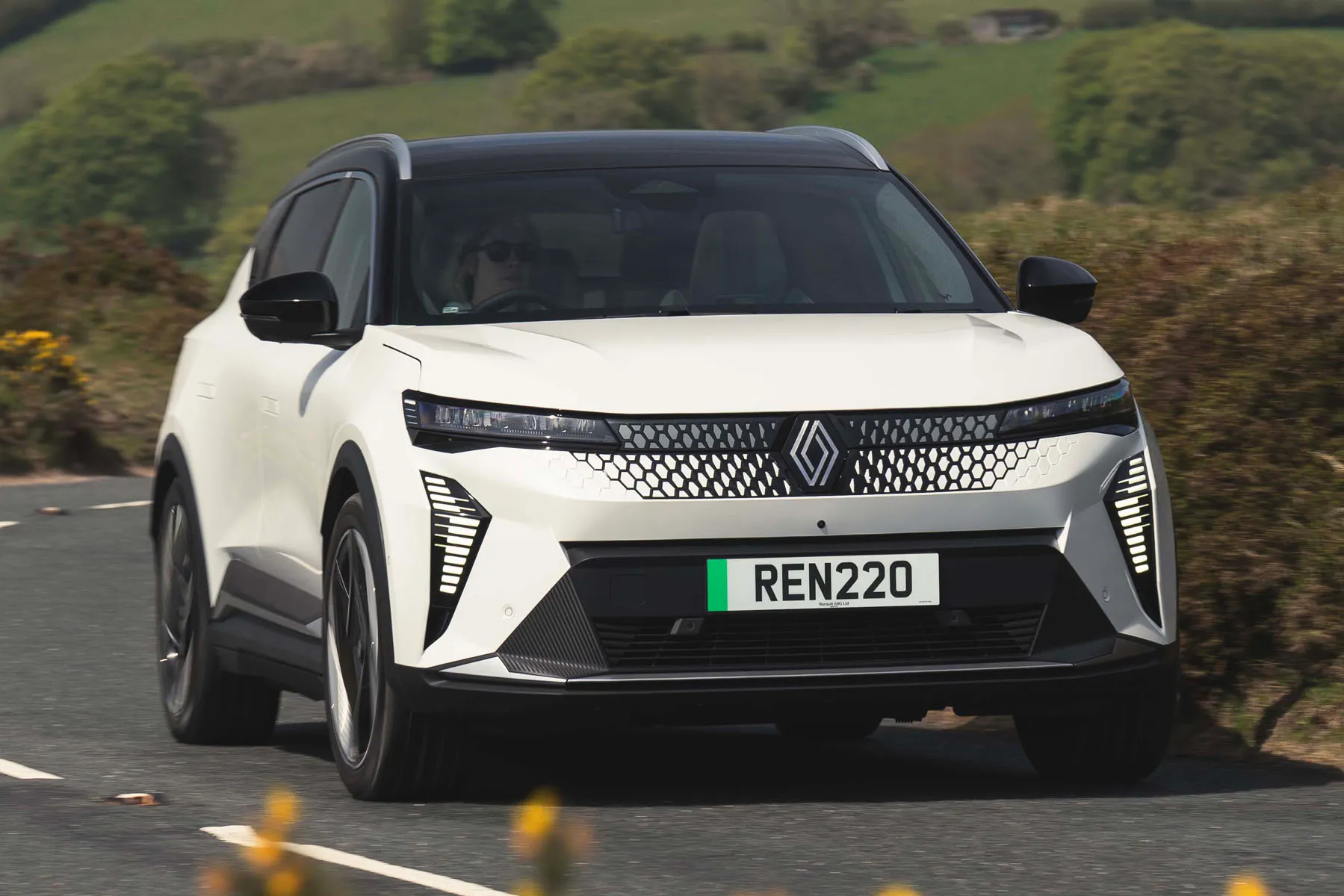
So it’s strange to think, then, that it took Renault so long to come up with a mainstream, all-electric family car. That was the Megane E-Tech, and following that is this Renault Scenic E-Tech electric. Officially, it’s not an MPV. Of course not, it’s an SUV, right? Hmm, no, apparently not. Agreed, the current Scenic does look suspiciously like an SUV, but Renault, very deliberately, isn’t defining its body style; it’s leaving you, the punter, to decide which box to put it in. Which, you could argue, is a pioneering approach to selling cars.
For simplicity’s sake, we’ll call the Scenic a family-sized electric SUV. It came initially in three trims – Techno, Esprit Alpine and Iconic – with two battery sizes. 60kWh is the smaller one, which comes with a 170PS motor, while the bigger-battery version stores 87kWh and delivers 217PS. The headline figure concerns battery range, though. The 60kWh officially manages a respectable 260 miles on a full charge, but the 87kWh model has the potential to travel up to 379 miles in one hit. That’s impressive, especially for a car in this price bracket. It beats the Tesla Model Y Long Range’s range, for example. Mind you, Teslas offer quicker charging speeds, but the Scenic’s relatively light weight makes its energy efficiency pretty close to the best.
In mid-2025, Renault revised the trim line-up to Techno, Techno Esprit Alpine and Iconic Alpine.
How much does it cost? Well, Scenic range begins at £37,195. Initially, it topped out around £45,500, although in 2025 that dropped to £42,195. The lower end of the range competes with the higher-end versions of smaller cars, like the Peugeot e-2008. Meanwhile, top-spec Scenics go toe-to-toe with the cheaper versions of some bigger cars: the Hyundai Ioniq 5, Kia EV6, Peugeot e-3008, Skoda Enyaq and the Tesla Model Y, for example. And if you’re umming and ahing about buying electric or sticking with petrol or diesel, the competition might widen to include the Skoda Kodiaq and Volkswagen Tiguan as well.
The Scenic’s certainly got the makings of a competitive package. The styling is thoroughly modern but deliberately ‘normal’: if you like cars to look like cars (as in, not too ‘out there’) you’ll probably like the Scenic. And you’ll like its practicality. There are bigger cars for Scenic money, sure, but the Scenic manages to cram a lot of interior space into its not-so-huge exterior dimensions.
It’s not quick next to a Tesla Model Y, but fast enough nonetheless – faster than a good many petrol and diesel rivals – and just as zippy as an Enyaq. In the main it’s quite comfortable, too, but Renault has definitely tuned the suspension to make it feel fun to drive.
As an all-round package, the Renault Scenic E-Tech is up there with the very best. There are very few electric cars that are as versatile, comfortable and enjoyable to drive as the Scenic E-Tech - especially with a starting price well below £40,000. Chuck in a very impressive range, and the Renault Scenic E-Tech is a very competitive family car.
Looking for a used car for sale? We've got 100s of Renault Approved Used Cars for Sale for you to choose from.
Is the Renault Scenic E-Tech right for you?
Yes, if you want a car that does most things well and few things badly. There are cheaper cars out there, for sure, but when you take into consideration practicality, battery range, the amount of tech you get, plus aspects like interior quality, the Scenic is well worth considering. The fact that it’s reasonably fun to drive is also a bonus.
The Tesla Model Y offers access to the best charging network, though, and the Kia EV6 is arguably a better all-round package, but both those alternatives come at a price.
What’s the best Renault Scenic E-Tech model/engine to choose?
So far, we’ve driven only the mid- and upper-trim levels with the bigger 87kWh battery. If ultimate range is key, then the 87kWh battery’s 379-mile official range makes it the one to buy.
That said, the 60kWh battery officially manages 260 miles on a single charge. It’s slower than the 87kWh version (0-62mph in 8.6 seconds instead of 7.9 seconds) but matches the pace of an entry-level Enyaq and it’s quicker than many traditional petrol and diesel rivals. The entry-level trim is well kitted out, too, and at around £37,100 we reckon it’s a tempting combination.
What other cars are similar to the Renault Scenic E-Tech?
When we asked Renault about which cars its Scenic is competing with, it said there’s not one particular car, or even a single segment, it’s aiming at. Family car, MPV, SUV, petrol, diesel, or hybrid; it’s all the same to them, apparently.
However, if you have around £37,500 to spend for the entry-spec Scenic, and you want an electric car, then the Kia Niro EV and Skoda Enyaq ranges start at similar money. The Enyaq 60 offers more interior space and a comparable range to the Scenic’s 60kWh battery, but isn’t as dynamic to drive.
If your budget stretches to around £45,500 then you could look at cheaper versions of the Hyundai Ioniq 5, Kia EV6, Volkswagen ID.4 and Tesla Model Y. And we have to mention the Nissan Ariya, because it shares the same underpinnings as the Scenic – although the top versions of the Ariya are much pricier. Meanwhile, you might want to consider the Ford Mustang Mach-E or Volvo XC40 Recharge for their more premium or evocative brand names, but you’ll need to find even more cash.
It’s worth noting that while some of the cars we’ve mentioned get near to the Scenic 87kWh’s 379-mile official range, none match it.
Comfort and design: Renault Scenic E-Tech interior
"If your first car was a clapped out Renault Clio (or, if you’re a little more mature, a well-worn Renault 4), then you might be surprised by the plushness of the Scenic’s interior. It has to be said, we haven’t seen the entry-level Techno trim in the flesh, but we’ve seen the two other trims that are available and, in main, came away impressed."
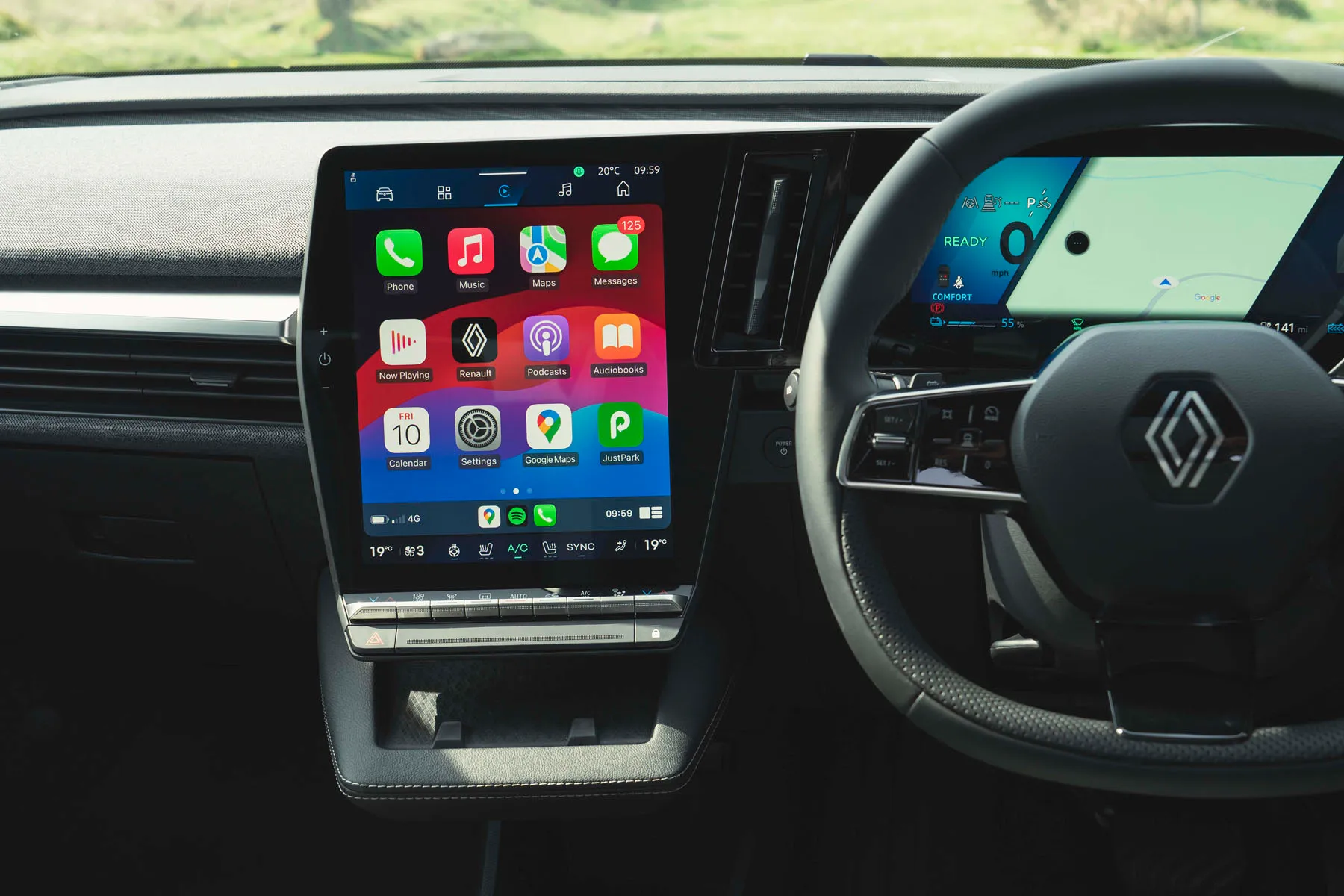
Renault’s gone big on sustainability with the Scenic. 24% is made from recycled materials – including faux leather made from old plastic bottles. And if that sounds a bit naff, think again.
Mid-range Esprit Alpine trim has a zesty, sporty feel, echoing Renault’s Porsche-rivalling brand, Alpine; that’s why you get swish sports seats with electric blue stitching, carpets and door trims. That injection of colour gives this version an appealing, vibrant look. Top-spec Iconic adds real wood trims as well as part faux-leather seats.
The sports seats (the only seats we’ve sampled) are supportive in all the right areas. If you go for the Iconic trim the driver’s seat is electrically adjustable with massage function. The steering wheel also has lots of adjustability, so you should find it easy to get comfortable no matter what shape and size you are. We like that there are a few physical buttons for the oft-used functions – climate control, audio settings, etc. They are far less distracting to operate while driving than touch-sensitive buttons.
The view out the front and sides is okay (the front and side pillars are chunkier than some rivals) but the major blight is rear visibility. The rear screen is like a letterbox and the back pillars are big, so you have to rely on the rear-view camera and parking sensors when reversing. Thankfully, those are all standard.
Quality and finish
As we’ve mentioned, there are lots of smart materials dotted about the Scenic’s interior that lift the ambience. For instance, all versions come with gloss black and chrome highlights on the dashboard, and from Esprit Alpine trim you get a soft, fabric dash that adds to the air of plushness. There are some neat touches that go above and beyond, too, like carpeted door bins front and rear. This stops your odds and sods rattling about and looks and feels pleasant, too.
It isn’t perfect, mind. There are some harder, less appealing plastics – most noticeably the top of the door trims – but while that’s a shame, you’ll find similar plastics in all its price competitors. And the fact is your eyes are drawn to the smarter bits, so overall the Scenic is a nice place to be.
What about build quality? Well, we’d say that matches up with its main rivals, too. Overall it’s at least as robust, if not sturdier, than an Enyaq when you start prodding and fiddling.
Infotainment: Touchscreen, USB, nav and stereo in the Renault Scenic E-Tech
There’s plenty to talk about here, which is good if you like your tech. For a start, when you climb aboard and press the start button the 12.3-inch driver’s display bursts in to life with welcome graphics and an accompanying tune by composer Jean-Michele Jarre – for younger readers, he’s a French composer who was mega famous in the 1980s. Both the driver’s display and the 12-inch portrait-orientated infotainment screen are crisp with easy-to-read graphics.
The infotainment system is generally easy to operate once you’ve learned your way around its various menus. It’s responsive, too. Renault told us that there will be a software update for the production cars to iron out some niggles, though. Any further software updates can be done over-the-air, which saves you having to book the car into the dealership.
The software is a version of Google's Android Automotive, which means you get Google Assistant, Google Maps and Google Play store – with around 50 apps available. On top of that it comes with wireless Apple CarPlay and Android Auto smartphone mirroring, and all versions have wireless phone charging along with USB-C sockets front and rear. Top Iconic trim is fitted with a high-end Harman Kardon sound system with a punchy delivery.
Space and practicality: Renault Scenic E-Tech boot space
There’s plenty of head and legroom in the front for a tall driver and passenger, and the interior’s wide enough that neither will be banging elbows on the centre armrest. Those in the rear are also well looked after. True, the Kia EV6 has more rear legroom, but the Scenic has enough; certainly enough to fit two six-footers behind their equivalents up front. The rear middle seat is a little narrower and higher than the outer two, but still fine for a fifth passenger when required. There’s no floor tunnel to straddle, either. Another highlight is the rear seating position. In a Tesla Model 3, the rear seat squab is so low to the floor that there’s little under-thigh support. The Scenic’s rear bench is set higher, so it’s more supportive.
Unfortunately there isn’t a sliding or reclining rear bench but the rear compartment has at least one clever feature. The rear armrest drops down to reveal two cup holders, which you can swivel round to reveal smartphone/ tablet holders – one for each outer-rear passenger. And when you lift up the armrest lid you’ll find extra storage space and two USB-C ports. If that’s not enough to keep the backseat passengers happy, there are also pockets in the back of the front seats for popping phones into. In fact, with all the various trays and cubbies – front and back – you’ll find plenty of storage space in the Scenic. Only the tiny glovebox blots its copybook.
There’s no problem with luggage space, either. The power-operated rear tailgate give access to 545 litres of carrying capacity. To put that into context, it’s only a few litres shy of the Skoda Enyaq’s boot and more than you get in a Kia EV6. Swallowing a pushchair won’t be an issue, then, and there’s another 38-litres of underfloor storage. That’s where the charging cables live because there isn’t a second boot in the nose, like you get with the Model Y.
When you drop the 40/20/40-split-folding rear seats, the space increases to 1,670 litres, but this reveals an issue: a big step in the extended boot floor. However, there’s a solution. Make sure you order the adjustable boot floor, which isn’t a hugely expensive option. It reduces the step when the rear seats are down and makes the loading lip smaller, too.
Handling and ride quality: What is the Renault Scenic E-Tech like to drive?
"If you’ve read much about electric cars, you may’ve noticed people moaning about how heavy they are, especially those with big batteries like the Renault Scenic E-Tech. It’s not unusual for electric cars of the Scenic’s size to weigh over two tonnes (a Volkswagen ID.4 can be more than 2.2 tonnes). That’s vastly more than a petrol or diesel equivalent. The Scenic’s an EV lightweight, though. The 60kWh version is a little over 1.7 tonnes and the 87kWh weighs just over 1.8 tonnes."
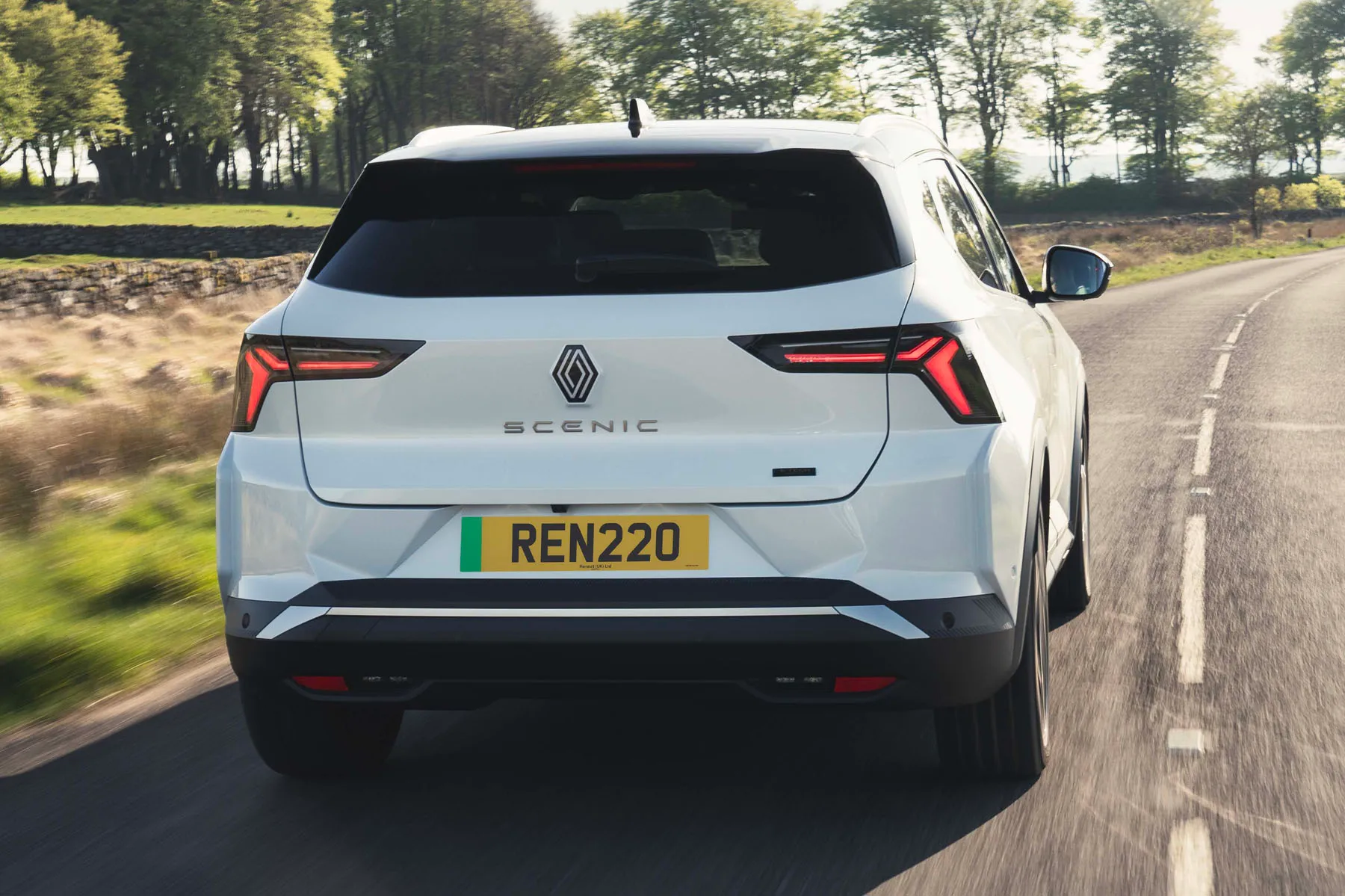
What’s the significance of this? Well, lightness helps in many ways. Take the Scenic’s handling, for instance. It’s no supercar, sure, but it’s one of the more agile-feeling electric SUVs to drive. It controls body lean around corners commendably, and over any dips and crests on fast B roads it stays planted. It gives you the confidence to drive it quickly.
The steering helps as well. It’s light (although you can add weight by switching to Sport mode) and quick-Early cars don’t have one-pedal braking, where you lift off the accelerator and the car slows to a stop. But the maximum of its four regenerative modes, which you control from paddles behind the steering wheel, still adds quite a pronounced braking effect. From mid-2025, Renault added one-pedal driving as standard across the Scenic range, although we've yet to try it.
What motors and batteries are available in the Renault Scenic E-Tech?
The cheaper option is the 60kWh battery coupled with a motor producing 170PS and 280Nm of torque. Not massive numbers, true, but good enough for 0-62mph in 8.6 seconds – similar to an Enyaq 60 and quicker than your average petrol or diesel family SUV. We haven’t tried this version yet, but we’ll let you know what it’s like once we have.
At this early stage we’ve tried only the 87kWh battery. It adds more range but also more performance, with 217PS and 300Nm of shove. Even that isn’t enough to match the Tesla Model Y’s crazy acceleration times, but it’s quick enough. 0-62mph is done in 7.9 seconds, and that’s plenty to get you off the line smartly at traffic lights and up to motorway speeds with ease. The other nice thing is how effortlessly you can increase speed thanks to the accelerator’s intuitive response.
Top speed is a little academic in the UK, but the 60kWh maxes out at 93mph and the 87kWh will keep going until 105mph.
Maximum electric range in the Renault Scenic E-Tech
This is a definite strength of the Scenic. Even the smaller 60kWh battery will officially carry on for 260 miles on a full charge. That compares well with an ID.4 Pure’s quite limiting 223 miles and is not far behind the Niro EV’s 285-mile maximum.
It’s the 87kWh battery that really does the business, though. If you travel long distances regularly, or simply have a serious case of range anxiety, then this version will go on and on until, officially, it runs out of charge after 379 miles. What else could you buy that tops that? Not much, really. It’ll still be going long after the Kia EV6 RWD has run out of puff at 328 miles and the Tesla Model Y Long Range at 331 miles – both more expensive cars, remember.
A heat pump is standard, which helps extend the battery range in extreme temperatures – it makes the air conditioning and the interior heating run more efficiently, and helps maintain the battery at its optimum temperature as well.
Refinement and noise levels
There’s next to no noise from the electric drivetrain while you’re driving along. It accelerates almost silently, and the only time you hear a faint whine is when you lift off and the motor starts harvesting electricity to top up the battery.
Road noise is also very well isolated; unless the surface is truly rough there’s not much drone from the tyres. The main thing you’ll hear is wind noise, but even at 70mph it’s something you’re aware of but it’s not a deal breaker.
Safety equipment: How safe is the Renault Scenic E-Tech?
Renault claims up to 30 safety assist systems for the Scenic, which includes a Safety Coach that rates your driving. This assesses data, such as how you accelerate, how much distance you leave to cars in front (there’s a handy readout on the dash that tell you the distance in seconds), speed limit awareness, etc.
The motorway and traffic assistant Active Driver Assist combines adaptive cruise control, Stop & Go and lane centring that adapts to the road. At low speeds, such as in a traffic jam, the lane centring system can be adjusted by the driver to keep the vehicle to one side of the road to ease the passage of emergency vehicles.
The Intelligent Contextual Adaptive Cruise Control system uses GPS data so the Scenic knows when to slow for upcoming roundabouts, bends and changes in speed limit. And, of course, there’s also active emergency braking to help prevent an accident, which detects cars, cyclists and pedestrians, as well as a secondary braking that puts the brakes on after a shunt.
So far the Scenic hasn’t been tested by Euro NCAP. We’ll update you with the results when it has.
Charging times: How much does it cost to charge the Renault Scenic E-Tech?
"The 60kWh battery charges at up to 130kW DC, while the larger 87kWh battery can manage a tad better: 150kW DC. That’s decent. It’s better than an ID.3 or Enyaq, but someway off the fastest-charging competitors – an EV6 can, theoretically, charge at up to 238kW."
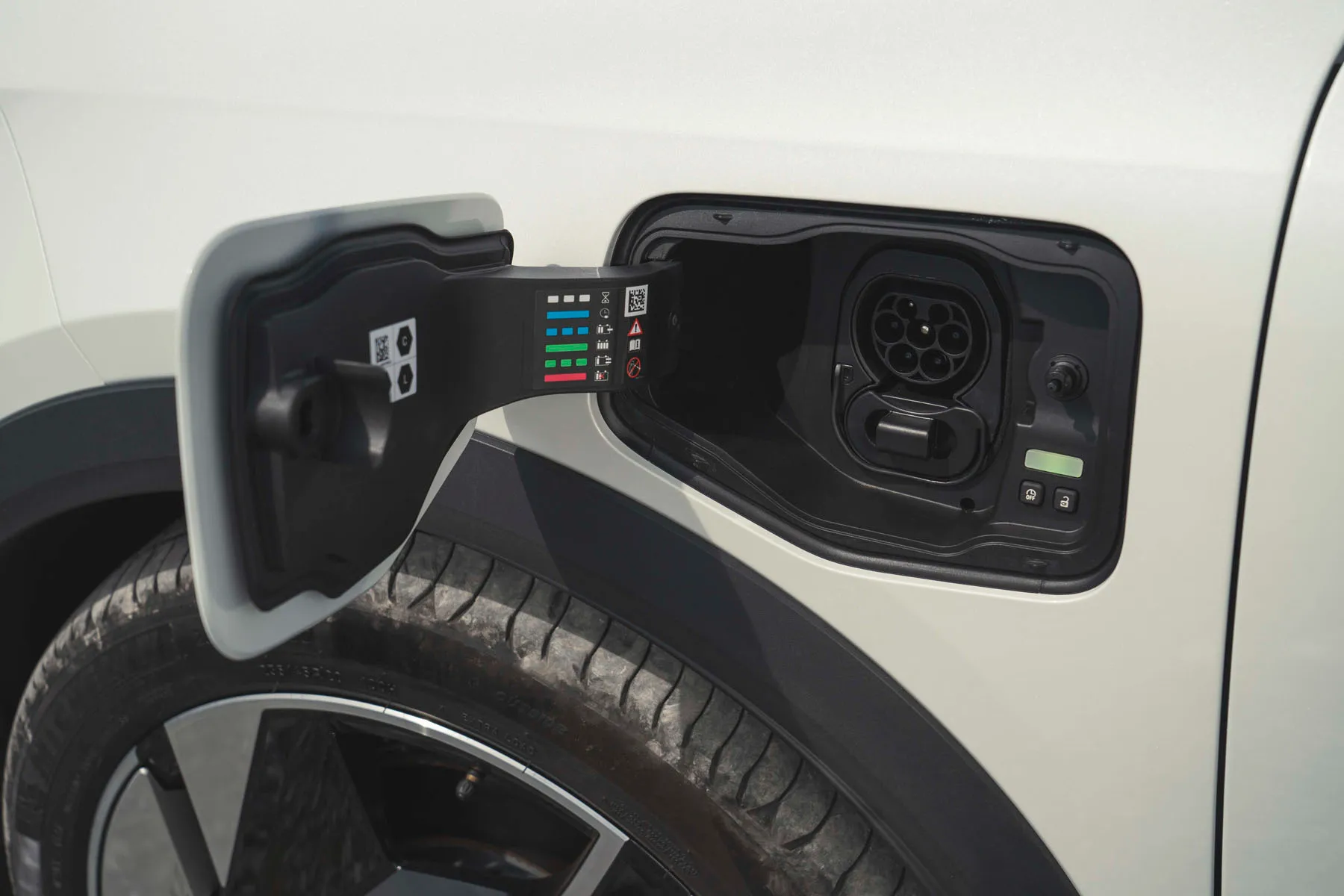
However, the actual charging speeds of EVs vary wildly due to many factors. Renault says it has worked hard to offer a consistent averaging charging curve of around 110kW. In theory, then, you should be able to fast charge from 0 to 100% in 1 hour and 20 minutes (87kWh battery). A more real-world example is the potential to add two hours of motorway driving with a 30-minute fast charge.
You’ll need around 13 hours to charge the 87kWh battery from a 7kW home wallbox, while the smaller 60kWh battery will need around 9 hours to fully charge. A 22kW on-board charger is available as an option for those that have access to three-phase electricity.
To fully charge the 87kWh battery at home could cost around £10 if you’re on one of the cheaper tariffs. But a full charge at a public fast charger might be as much as £75. Ouch.
The journey planner, which runs in conjunction with the Google Maps, pre-conditions the battery as you’re heading to the next planned charging stop. It means the battery will be at the optimum state to charge as quickly as possible. You can see the charging speeds and payment methods of the chargers on your route, too. Even the weather is taken in to consideration to help estimate the range you have left as accurately as possible.
How reliable is a Renault Scenic E-Tech?
The Renault Scenic E-Tech is too new for us to have any idea of how reliable it will be. But as a brand, Renault finished down the bottom – last but one place – in our latest HonestJohn.co.uk Satisfaction Index. The good news, though, is that electric cars tend to be more reliable than their petrol or diesel counterparts. There are less moving parts to go wrong - and we've heard of very few issues with other Renault EVs, including the popular Renault Zoe.
Insurance groups and costs
The entry-level Scenic 60kWh is in insurance group 28. The rest of the range is in group 32. That’s quite reasonable for a large EV in this price range.
VED car tax: What is the annual road tax on a Renault Scenic E-Tech?
Because the Renault Scenic is all-electric, there’s no VED (road tax) – unless the government changes that situation in years to come. Which it currently plans to do from 2025 - but enjoy the tax break while you can.
How much should you be paying for a used Renault Scenic E-Tech?
"A new Renault Scenic E-Tech starts from around £37,500 for the smaller 60kWh battery in the entry-level Techno trim, rising to just over £45,000, for the 87kWh battery in top-spec Iconic trim."
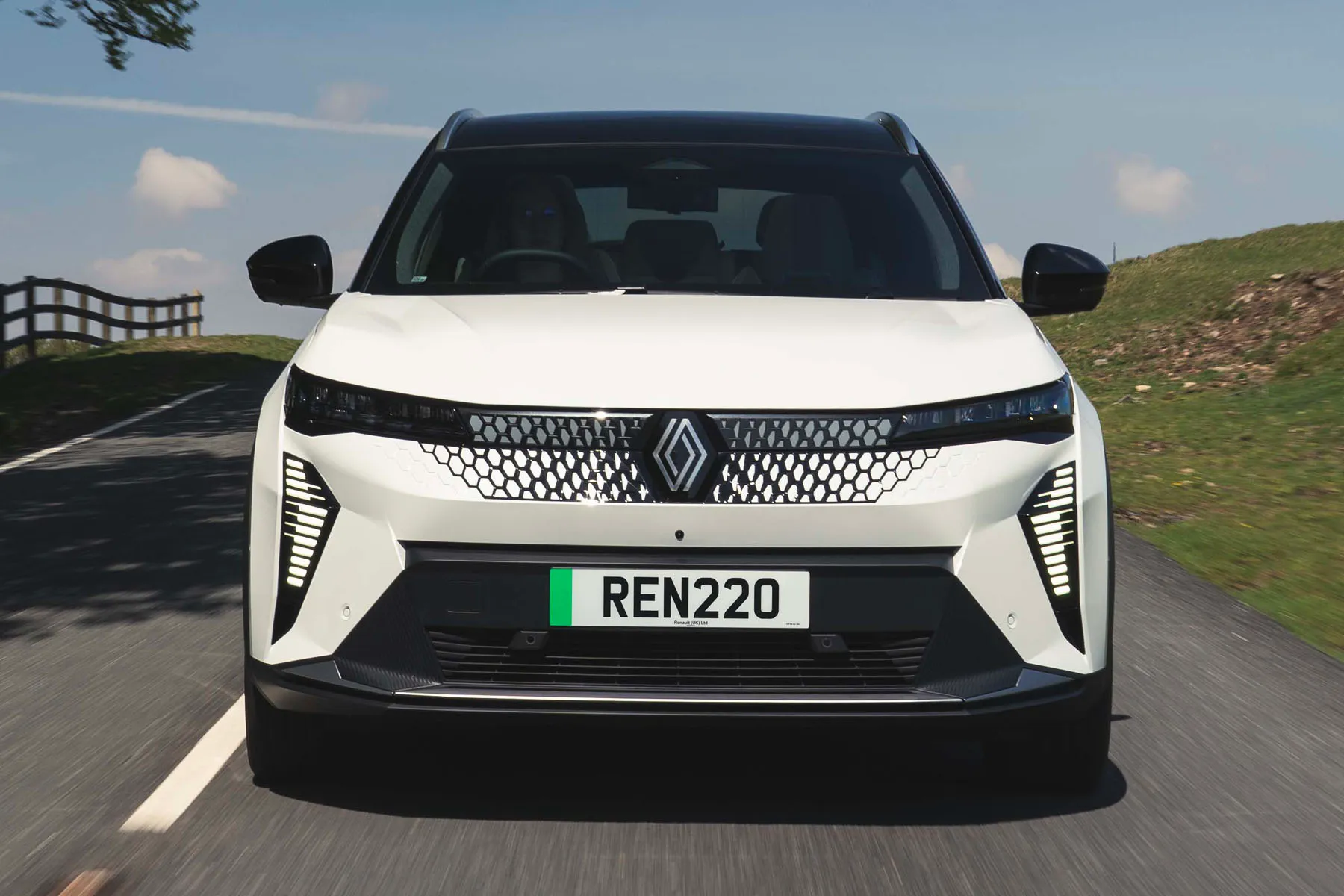
That makes a new Renault Scenic E-Tech pretty competitively priced in the market - you'll pay around £39,000 for the cheapest Skoda Enyaq iV, while the Hyundai Ioniq 5 range starts from nearly £43,500. The most affordable Tesla Model Y is £45,000.
You can save money by searching for a used Renault Scenic E-Tech, too. While the model is brand new in the UK, we've already seen discounts being offered on pre-registered and ex-demonstrator models. We've seen one dealer advertising a Renault Scenic Techno for a smidgen over £36,000. Give it time, and you'll no doubt be able to save even more money on a nearly-new Renault Scenic E-Tech.
Trim levels and standard equipment
Even the entry-level Techno trim Scenic comes well equipped. We’ve mentioned some of the items already, such as the 12.3-inch driver’s display, 12.0-inch infotainment screen, wireless phone charging, wireless smartphone mirroring, adaptive cruise control, a powered tailgate, a rear-view camera and parking sensors front and rear. That’s not the end of it, though. You also get 19-inch alloys, dual-zone climate control, automatic lights and wipers, power-folding door mirrors, LED headlights, heated front seats, heated steering wheel, ambient interior lighting and a heat pump.
Esprit Alpine trims adds 20-inch alloys, heated sports seats and upgraded trims including blue interior detailing. It was renamed Techno Esprit Alpine in mid-2025, and also gained a face ID feature that can identify the driver and automatically set their preferred profile and seat position.
Iconic adds an electric driver’s seat with massage function, Harman Kardon sound system, part faux-leather seats, wood trim, automatic parking and a 360-degree parking camera. Also you get a rear-view mirror that turns into a screen, which shows you what’s behind even when the view through the rear window is blocked. And also something called a Solarbay Roof. Instead of a simple blind to stop glare, this full-length glass roof has polymer-dispersed liquid crystals that make individual sections of the glass opaque at the touch of a button.
The top trim was renamed Iconic Esprit Alpine in mid-2025, bringing the same Alpine-inspired vibe as the mid-spec model.
Ask the heycar experts: common questions
Is the Renault Scenic E-Tech a good car?
How quick is the Renault Scenic E-Tech?
How expensive is the Renault Scenic E-Tech in the UK?
Get our latest advice, news and offers
Keep me updated by email with the latest advice, news and offers from heycar.
By submitting you agree to our privacy policy